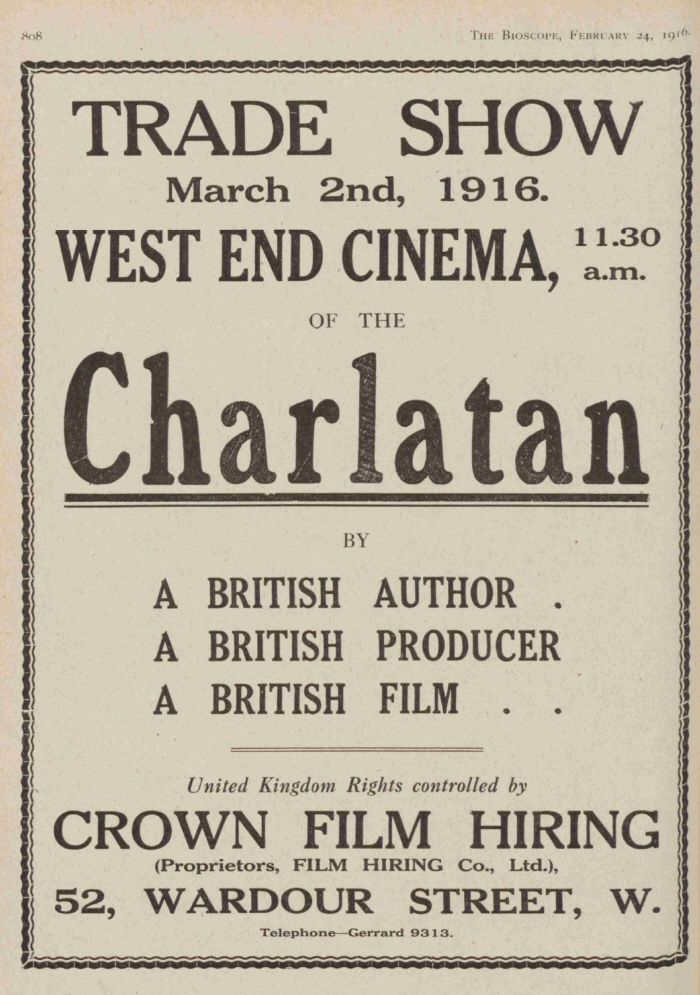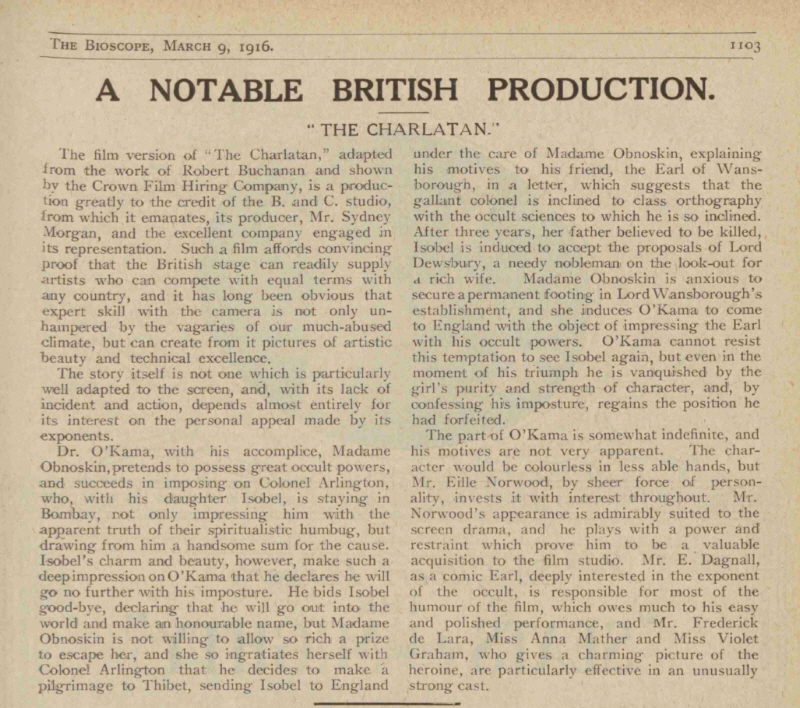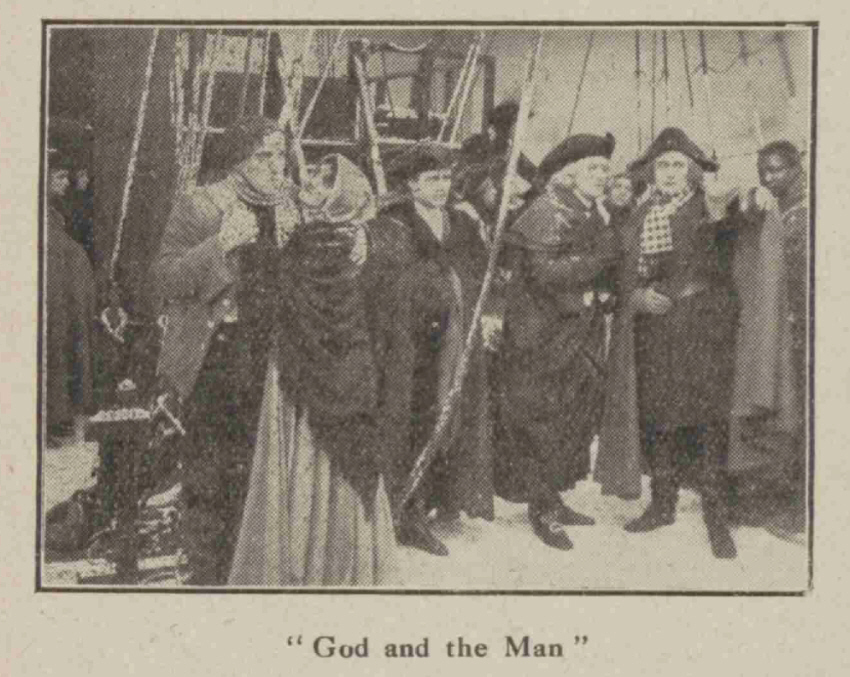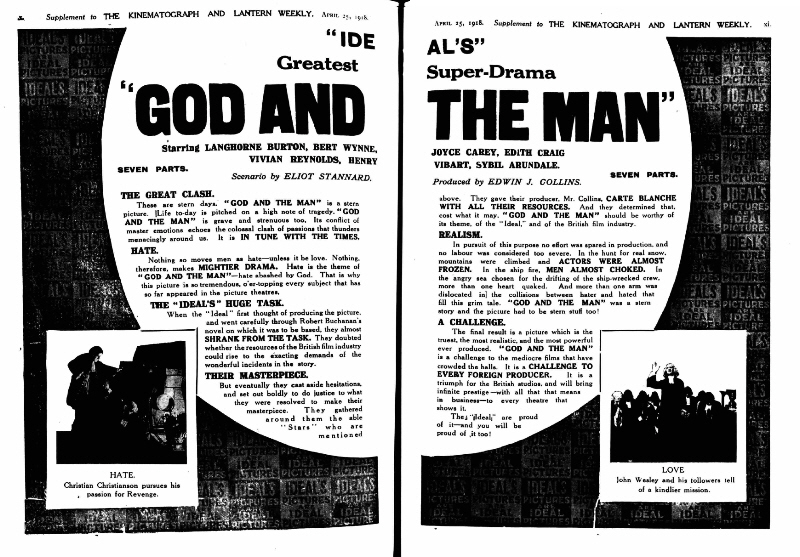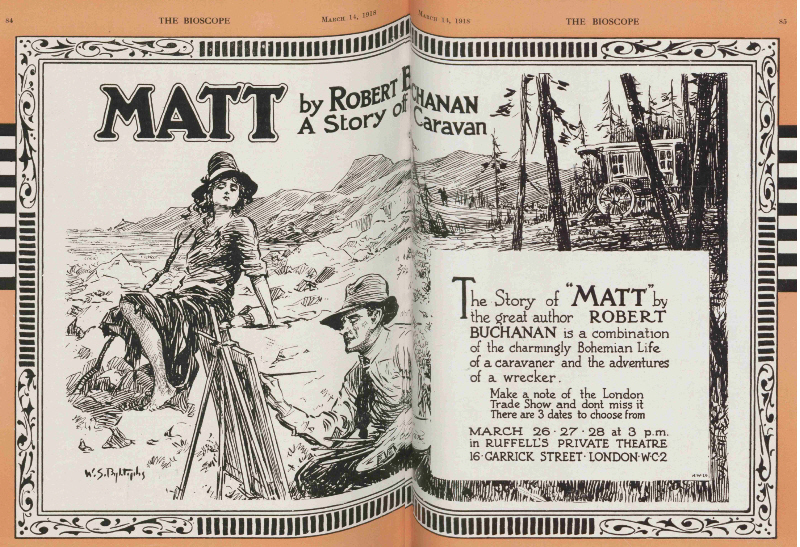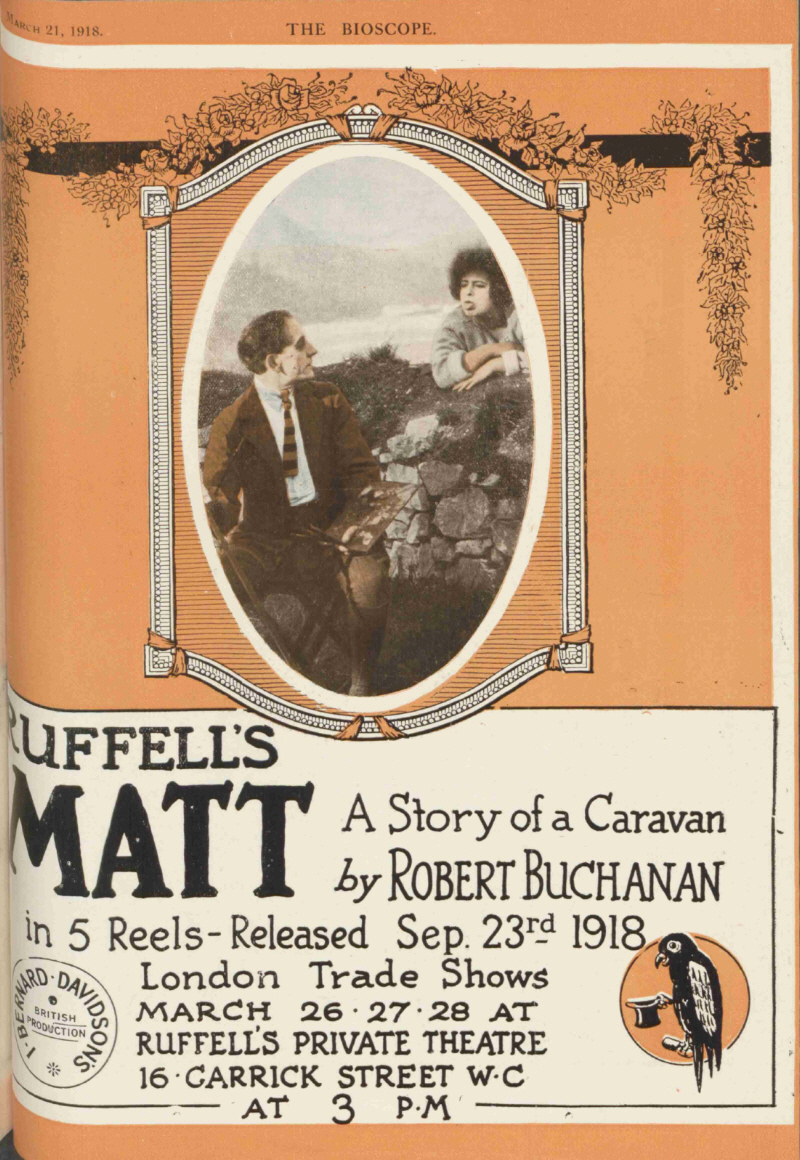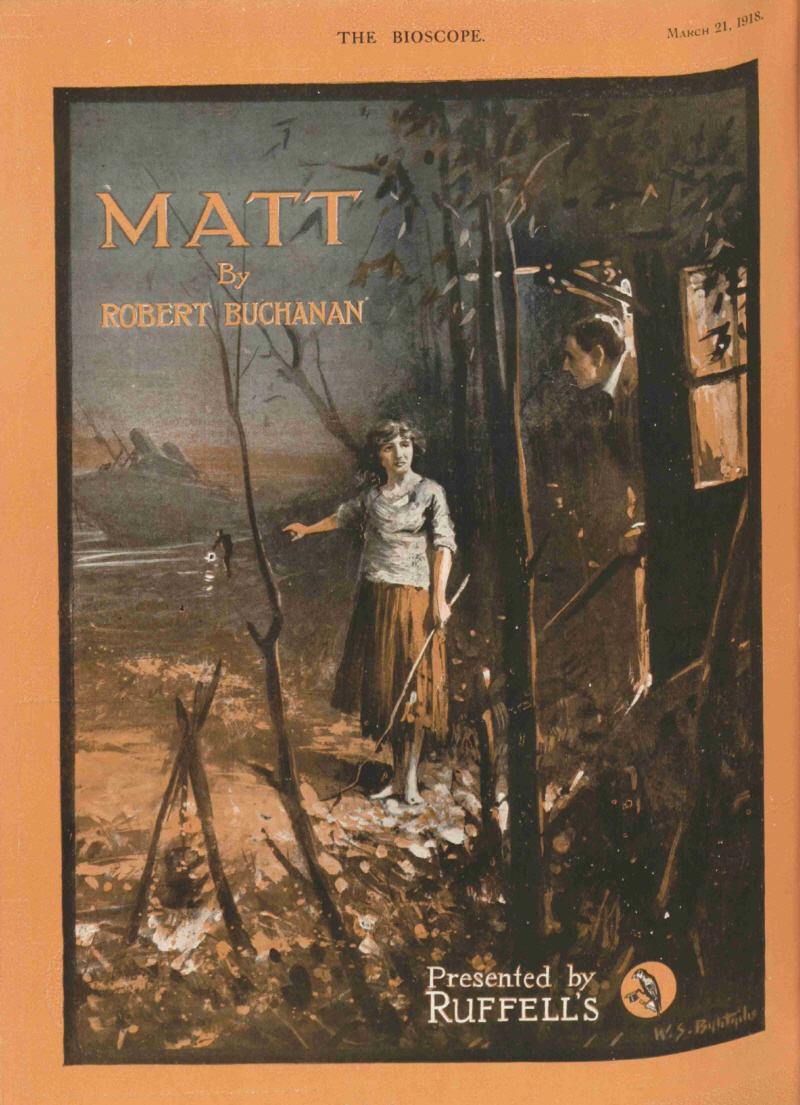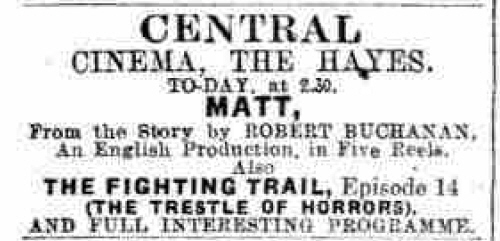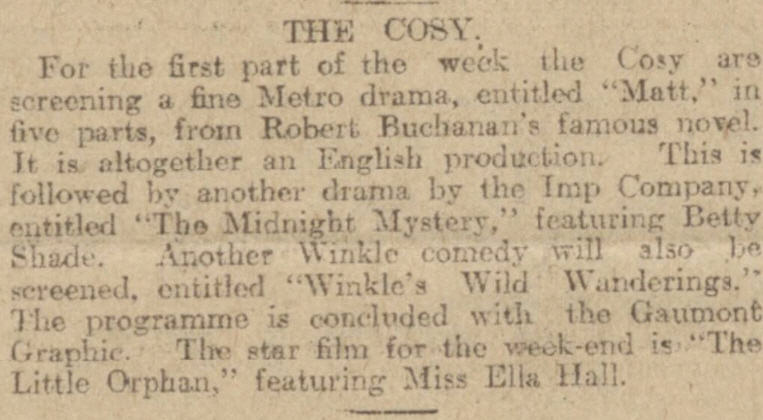|
Among the chief actors in this brilliant cast are Mr. Langhorn Burton, whose Christiansen is magnificent in its strength and pathos of a man under the spell of vengeance, Mr. Bert Wynne, a cruel, relentless foe, and Mr. Nelson Ramsey as Squire Christiansen, one almost maddened with rage.
The Dame Christiansen of Miss Edith Craig was a powerful study of wounded pride and rousing resentment, and Henry Vibart’s converted man of the world is fine.
Mr. E. Vivian Reynolds’s John Wesley stands out as a figure of the living truth of a living religion, a remarkable characterisation indeed.
The gentle Priscilla of Miss Joyce Carey wins all hearts; her truly womanly appeal to the best in both men who love her, even though one is a hypocrite to the core and the other a creature obsessed by his wrongs.
Miss Sybil Arundale’s poor deceived and tortured Kate is superb in its heart-breaking pathos; a true-to-life picture of one who loved not wisely but too well, but through the valley of humiliation and disillusionment found the way to happiness after all.
With this picture the Ideal Film Renting Company have made their most ambitious effort, and have every reason to be proud of a production that is one of the most interesting that has yet come from a British studio, and the same praise applies to Mr. Edwin J. Collins, the producer, and Mr. Eliot Stannard, who is responsible for the scenario.
(p.36)
GOD AND THE MAN. Ideal Film Renting Co.
All British Drama, 8 reels. Trade Show (West End Cinema), April 18th.
Robert Buchanan’s powerful, widely read novel has been faithfully adapted by Eliot Stannard and skilfully filmed by Edwin J. Collins for the Ideal Film Co. It is beyond doubt one of the best “All British” productions offered to the public, and should have a decided success in foreign markets as well as generous support in the United Kingdom. A strong, clever, and judiciously selected cast, consisting of Joyce Carey, Sybil Arundale, and Edith Craig; Langhorne Burton, Henry Vibart, and Vivian Reynolds (the last named might have stepped out of John Wesley’s medallion in the Abbey) do every justice to both author and producer. There are some unusually clever studio effects, notably the snow-clad rescue ship which so nearly gets crushed on the ice-bound coast of Labrador, these are extraordinarily realistic. Affecting scenes of revival mission work by John Wesley and his followers are reverently stage-managed. I am of opinion the film would be improved by reducing the length of the first few reels, but it is not easy to suggest what parts might be shortened.
___
The Kinematograph And Lantern Weekly (25 April, 1918 - p.73)
THE IMPRESSION OF A GREAT PLAY.
“God and the Man.” “Ideal’s” All-British Masterpiece.
He that wrongs his friend
Wrongs himself more, and ever bears about
A silent Court of Justice in his breast.
Himself the judge and jury, and himself
The prisoner at the bar, ever condemn’d.
And that drags down his life.
Tennyson.
TO the intense religious fervour of Wesley and his followers adheres closely the vivid touch of human life, the life of to-day, even as in the days of Wesley, and thus affording the text for the sermon. The power of this combination is enhanced by the realism in portrayal, the greatness of the scenic effects, and the highest class of dramatic art. And hovering at all times over the play, and visible constantly, is the remarkable cleverness of the scenario, which has moulded the serious theme not only into the understandable, but also towards the attractive. This is an achievement of which Eliot Stannard may well be proud, for the story of Robert Buchanan itself is great, and makes one of the most powerfully impressive screen plays yet produced. With stern grimness throughout it preaches the evil of hatred and vengeance. But it preaches in acceptable fashion, without hindering conviction.
Whilst no deviation is made from the main theme, it is made so human, with interpreting characters that charm and with incidents and scene that please the eye as well as enlist our sympathy. And once sympathy is aroused, it is but a narrow step to conviction.
The strongest point, to my mind, of “God and the Man” as a story, and one strongly enough borne out by the screen play, is its straightforward fairness. The characters are drawn with a strong hand, the cause of and case for hatred is absolutely made the most of; there is no loophole for cynical comment. Whether hatred is right or wrong, the justification for it is put at its maximum. The case for hatred and revenge is fully set out, and convincingly. For as we judge from the human standpoint to which we have attained, no man has, or ever had, stronger reasons for hatred than Christian Christianson. His father dies through the shock of having all his land bought over his head, leaving but the bare roof of his house to call his own. His sister is betrayed by the son of the same family, and the disgrace of this kills the mother. From this wreckage of hope, of life itself, it is laid to the charge of the scenario writer to bring this much-wronged man into paths of goodwill. “Vengeance is mine,” saith the Lord, “I will repay,” is an admonition perhaps worn a little threadbare in its passage through the ages, but yet eternal truth, as “God and the Man” amply proves, and proves in a skilfully convincing fashion. Leaving out all the other things, the hatred robs Christian Christianson of an inheritance of love which he may not enter.
So much for the story and its motive, and so much to the credit of Eliot Stannard’s interpretation on the screen. And if the story be great, what is to be said of the production by Edwin Collins, with such an enterprising British firm as the Ideal behind? Under their guidance we are given conceptions, rare imaginations and beauty.
Set as it is in the period of George II., with all the power of the preaching of John Wesley and the earnestness of his followers, we pass through a vista of the rusticity of England at that period and the intense power of the great revivalist, John Wesley (E. Vivian Reynolds). Priscilla and her father become converts, and forthwith devote their lives to the chief doctrine, love for mankind, not the gratification of evil-passioned hatred.
The impression upon the exhibitor at the trade show will be accentuated upon the audience. The play carries us on to a vivid fire on board ship, the saving of all on board by a Dutch vessel, which in turn narrowly escapes destruction by an iceberg, and is finally frozen up in the ice off the coast of Labrador. Where shall we find greater realism than the moving of the ice floes and the escape of the vessel; and, lastly, those grim death struggles of the two men left stranded there?
The acting, too, will make an impression. The hypocrite son of Squire Orchardson, who pretends conversion in order to win the fortune of Priscilla, the sweet but earnest convert, so beautifully rendered by Joyce Carey. This is the man who betrays Kate, the sister of Christian, a strong, emotional part for Sybil Arundale. The man of hatred, Christian, is one of the best things Langhorne Burton has given us, in its vigour and power. But, without detracting in the least from these artistes’ share in the great play, from a character creation point of view Edith Craig stands out predominant. Her Dame Christianson is a fiercely hating woman, who finds her reason for hatred in the Bible, and who compels her son to swear eternal hatred to the family of Orchardson by oath, with the Bible as witness.
My own impression of “God and the Man” is summed up in the simple words, “a great play.” Ideal throws out a challenge to foreign producers. I follow the example with a challenge to our play critics. “God and the Man” is eight reels long, it took two hours and ten minutes at the West End Cinema, shown at a proper speed.
Of such a play I have but attempted the impression, and with a really great play the description needs but little use of the adjective, for the superlative is superfluous.
W. DE W.
[Note:
The review was accompanied by two stills from the film, however the copy is not grayscale, but monochrome, so the quality is not too good. Still, I’ve added them below.]
|
